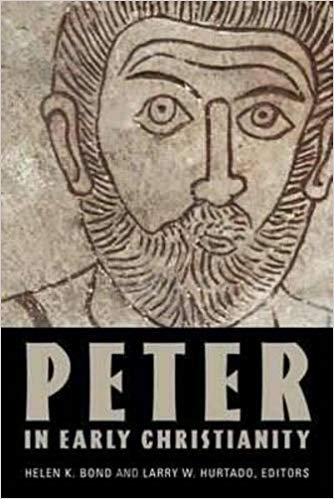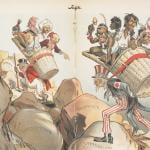Our last post on this book on Peter will deal with the lengthy and helpful essay of Peter Lampe on the indications in Rome of veneration of Peter and his burial place. Lampe is of course the one who wrote the best book on the development of the Church in Rome from the first century and beyond the apostolic era, focusing on archaeology and the social historical materials. From Paul to Valentinus: Christians in Rome in the First Two Centuries, (Fortress Press). First of all, already in 1 Clement5.4; 6.1-2 it seems clear that at the end of the first century in Rome it was taken for granted that Peter and Paul were martyred in Rome. Lampe’s interest is not in this fact, but rather in the devotion that sprang up around the belief that Peter was martyred there. He quotes Gaius (in Eusebius) from around 200 A.D. who speaks of the victory monuments of the apostles. If one goes to the Vatican today, you will know that there is a place underneath the basilica where Peter’s remains are said to be buried. Now that basilica or at least its apse was constructed originally sometime between 337-61 on the order of Constantius. When they began building they had no doubt that Peter’s grave was underneath that spot, and they removed and reinterred the bones wrapping them in a red cloth with golden threads. They were found underneath the edicula and Red wall area. As Lampe says, the archaeological and collateral evidence as we have it offers the possibility that Peter’s bones really were there, but there is no air tight proof of this theory. However, and it is a big however, many early Christians seem to have believed it was so, and some of the more wealthy ones wanted to be buried near Peter,in the mausoleum just to the east of this spot, and these graves sometimes have interesting Christian motifs and inscriptions. We have Jonah being thrown overboard, and Christ depicted as Sol Invictus (the rising sun) in a carriage with horses, much like Apollo was also depicted. More importantly just 20 meters from Peter’s tomb is the mausoleum of the Valerii built around 300 A.D. which includes the inscription :PETRVS ROGA (WITH THE TAU RHO LIGATURE OR ANKH SYMBOL)/PRO SANCTUS/HOMINI/CHRESTIAN/CORPUS SEPULTIS. “Peter, pray to Christ Jesus for the holy Christian people, who are buried at your body”. Peter’s name was often abbreviated as P, or PE, or PET in such inscriptions. Christians before Constantine were intentionally cryptic in their inscriptions to avoid persecutions from Diocletian and others. More importantly (and I have seen this evidence in person) there is a Greek graffito on that famous aformentioned Red Wall which reads PETP ENI… or Peter is in here, or possibly Peter [rests] in peace. This seems to come from before Constantine’s time. Indeed, from around the time of Gaius in 200 (see p. 280).
Lampe conjectures that the ankh, which is the symbol of a key, in the former inscription (see above) could be a reference to Peter holding the keys to the kingdom. Rather than there being a Tau Rho cross at that point. There is evidence as he shows that this tomb was already being venerated in the middle of the second century A.D. One of the most interesting further details is the examination by Lampe of the Christian catacombs. Of the some 35 images of deceased persons in the Roman catacombs, 11.5 were accompanied by Peter, and only 3.7 by Paul, and this should be compared the various attempts of Christians to be buried near the grave of Peter. This may reflect that the more Jewish Christian groups wanted to be near Peter, their apostle, the more Gentile ones near Paul. This might also explain the Jonah motif, an image from the OT which Jewish Christians saw as a foreshadowing of the resurrection of Jesus. And it is also interesting (p. 291) that twice Peter’s denials of Christ are depicted in these catacombs. Lampe is probably right that these motifs come from Christians who had been martyred and before martyrdom had denied Christ in fear perhaps much earlier in life, like Peter, and so were hoping for a similar forgiveness and restoration thereafter. Lampe goes on to deal with sarcophagi (pp. 300ff.) and interestingly discovers that Peter is regularly depicted as performing a miracle like Moses of providing water from the rock for thirst soldiers. And there are 64 examples of his being depicted on the sarcophagi as being arrested by soldiers, but is teaching them, holding a scroll in his hands. There is one example of him reading from a book scroll while his military guards listen. Lampe suggests the water from the rock motif has to do with baptism or the waters of eternal life Peter is offering his tormentors (like Jesus did the bandit on the cross), and he adds that this may reflect upper class Christians who were the subject of torture and execution, treating their captors in a Christ-like manner (p. 302). A few conclusions are possible. Clearly we see the rise of the figure of Peter in the tombs and sarcophagi in comparison to the paucity of such images or inscriptions involving Paul. Secondly, it is also true that Jerome supported Bishop Damascus in Rome’s usurpation of the use of Peter as ‘founder in Rome’ whereas in the east, the eastern church still claimed Peter for Antioch. This is one of the things that led to the split between Orthodoxy and the Roman Church– an obvious power struggle with Peter in the middle of the tug of war.













